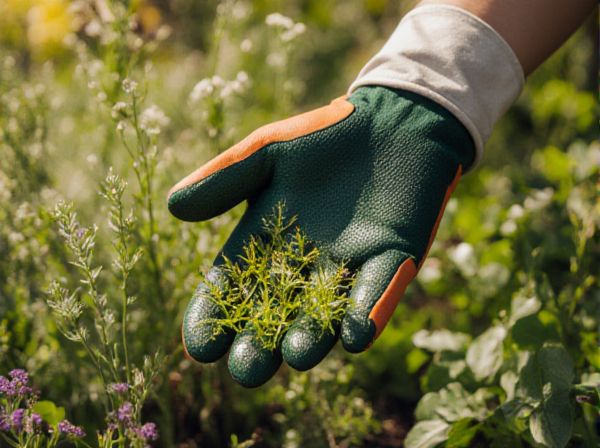
Annual weeds vs perennial weeds Illustration
Annual weeds complete their life cycle within one growing season, germinating, flowering, and producing seeds before dying, making them easier to manage through timely cultivation and mulching. Perennial weeds persist for several years, often spreading through deep root systems or rhizomes, which require persistent control methods like targeted herbicides or repeated removal to prevent regrowth. Effectively distinguishing between annual and perennial weeds allows for more strategic and sustainable weed management practices in gardens and agricultural fields.
Table of Comparison
| Feature | Annual Weeds | Perennial Weeds |
|---|---|---|
| Life Cycle | Complete life cycle within one year | Live for multiple years |
| Reproduction | Reproduce mainly by seeds | Reproduce by seeds and vegetative methods (roots, rhizomes) |
| Growth Pattern | Fast-growing with quick seed germination | Slow initial growth but persistent root system |
| Control Methods | Manage with timely herbicides and tilling before seed set | Require persistent control, including root removal and systemic herbicides |
| Examples | Crabgrass, Pigweed, Foxtail | Dandelion, Bindweed, Johnson grass |
Understanding Annual Weeds: Characteristics and Life Cycle
Annual weeds complete their life cycle within one growing season, germinating, flowering, and setting seeds before dying. They usually spread rapidly through seed production, making timely control essential for prevention. Common examples include crabgrass and pigweed, which thrive in disturbed soils and compete aggressively with crops.
Perennial Weeds Explained: Growth Habits and Longevity
Perennial weeds possess robust root systems that enable them to survive and regrow year after year, often spreading through rhizomes, tubers, or deep taproots. Species such as bindweed, dandelion, and quackgrass demonstrate remarkable longevity due to their ability to store nutrients and withstand adverse conditions. Effective control typically requires a combination of cultural, mechanical, and chemical methods targeting both the foliage and root structure to disrupt their persistent growth cycle.
Key Differences Between Annual and Perennial Weeds
Annual weeds complete their life cycle within one growing season, germinating, flowering, and dying within a year, which makes them easier to control with timely interventions. Perennial weeds persist for multiple years, spreading through extensive root systems and requiring more aggressive, long-term management strategies such as deep root removal or systemic herbicides. Understanding these key differences helps in selecting targeted weed control methods that minimize crop competition and prevent future infestations.
Common Types of Annual Weeds in Gardens
Common types of annual weeds in gardens include crabgrass, chickweed, and lamb's quarters, which complete their life cycle within one growing season. These weeds germinate quickly, spread rapidly, and produce abundant seeds, making them a persistent problem for gardeners. Effective management involves timely removal before seed set and maintaining healthy soil to suppress their growth.
Common Perennial Weeds: Identification Tips
Common perennial weeds such as dandelions, bindweed, and clover can be identified by their persistent root systems that survive year after year, making eradication challenging. Look for deep taproots in dandelions, twining stems in bindweed, and trifoliate leaves in clover to accurately distinguish these species. Recognizing these characteristics helps in selecting targeted control methods to manage perennial weed infestations effectively.
How Annual Weeds Spread and Germinate
Annual weeds spread primarily through seed production, releasing thousands of seeds into the soil to ensure rapid germination and growth each season. These seeds often require specific environmental cues like temperature fluctuations or moisture to break dormancy and initiate germination. Effective weed management targets interrupting this seed cycle to reduce annual weed populations in agricultural and garden settings.
Perennial Weed Reproduction: Seeds vs. Roots
Perennial weeds reproduce through both seeds and underground root systems, making them more persistent and difficult to control compared to annual weeds that rely solely on seed production. Their robust root networks, including rhizomes and tubers, enable regeneration even after the above-ground parts are removed, ensuring continuous growth year after year. Effective management requires targeting both seed dispersal and damaging the root structures to prevent regrowth and spread.
Effective Control Methods for Annual Weeds
Annual weeds, which complete their life cycle in one growing season, require targeted control methods such as pre-emergent herbicides and timely cultivation to prevent seed germination. Employing mulching and proper irrigation techniques disrupts the growth of annual weeds by limiting sunlight and reducing soil moisture favorable to weed seeds. Consistent monitoring and removal before seed set are crucial for effective control and minimizing future infestations of annual weeds.
Long-term Management Strategies for Perennial Weeds
Perennial weeds such as bindweed, dandelions, and quackgrass develop extensive root systems that make them challenging to eradicate compared to annual weeds like crabgrass or pigweed. Long-term management strategies for perennial weeds include consistent monitoring, targeted herbicide application during active growth phases, and mechanical removal techniques such as deep tilling to disrupt root structures. Integrating cultural practices like crop rotation and maintaining dense, competitive vegetation can suppress perennial weed regrowth and improve overall control efficacy.
Choosing the Right Weed Control for Your Garden
Annual weeds complete their lifecycle within a single growing season, making timely removal critical to prevent seed spread and future infestations. Perennial weeds, such as dandelions and bindweed, persist year after year through extensive root systems, requiring more aggressive control methods like deep cultivation or systemic herbicides. Selecting the right weed control depends on accurately identifying the weed type and applying targeted treatments that address their unique growth patterns and reproductive strategies.
Annual weeds vs perennial weeds Infographic

 gardendif.com
gardendif.com